

KITAOKA Fumio (北岡文雄)
|
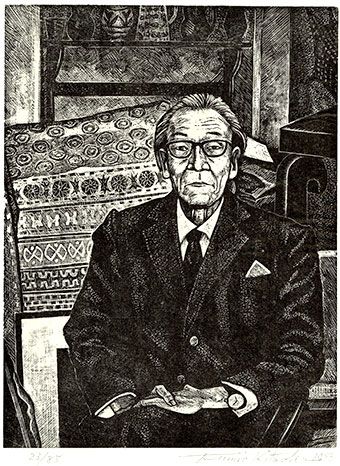 Kitaoka Fumio (北岡文雄 1918-2007) studied printmaking with Hiratsuka Un'ichi at the Tokyo Bijutsu Gakko (Tokyo School of Fine Arts, 東京美術学校). Hiratsuka was one of the principal figures in the sôsaku hanga movement who, between 1935 and 1944, taught the first block-printing course at the school. Graduating during the Second World War, Kitaoka initially taught art in Tokyo, but in January 1945 he was stationed as an art instructor in occupied Manchuria. His experiences in China led to the social-realist series titled Sokaku e no tabi (Return to the home country: 祖国への旅) in 1947 (see below).
Kitaoka Fumio (北岡文雄 1918-2007) studied printmaking with Hiratsuka Un'ichi at the Tokyo Bijutsu Gakko (Tokyo School of Fine Arts, 東京美術学校). Hiratsuka was one of the principal figures in the sôsaku hanga movement who, between 1935 and 1944, taught the first block-printing course at the school. Graduating during the Second World War, Kitaoka initially taught art in Tokyo, but in January 1945 he was stationed as an art instructor in occupied Manchuria. His experiences in China led to the social-realist series titled Sokaku e no tabi (Return to the home country: 祖国への旅) in 1947 (see below).
Kitaoka also became one of the many disciples of the seminal figure in abstract and experimental print design, Kôshirô Onchi. While active within the Onchi circle, Kitaoka produced some abstract work and contributed designs to Ichimokushû (First Thursday Collection: 一木集) issues IV to VI (plus the cover for IV, 1948), the important portfolios produced by the Ichimokukai (First Thursday Society: 一木会) headed by Onchi.
In the mid-60s, Kitaoka taught at the Minneapolis School of Art, where he was a Fulbright visiting professor (1964-65), and at the Pratt Graphic Arts Center in New York. Interviewed in the 1970s, Kitaoka said about his mid-career prints that, "I want to express through [my work] the profundity of nature and the feeling of eternity.... I feel that I should derive my creative activity from the deeper thoughts of the Orient, from a feeling that has its roots in Japanese nature and the Japanese way of living.... Form is meaningless without content, so I consider content more important. However, it is true that content itself cannot make a work of art unless it has an appropriate form. Form may take precedence over content in the immature state of a work of art, but in a consummate work, form and content are absolutely inseparable and should blend together in a perfect unity."
The vast majority of Kitaoka's early wood engravings were done in monochrome. However, the portrait shown above is one of Kitaoka's later monochrome works done in the early style. It is printed on thin Japanese ganpi (雁皮) paper that was mounted in the European chine-collé manner to heavier paper for printing in an intaglio press. The sitter was Hasegawa Kiyoshi (長谷川潔 1891-1980), a fellow artist widely known as an etcher and engraver who was dedicated to advancing the techniques of etching and mezzotint. A small-format work (image 163 x 123 mm), Kitaoka's engraving displays a consummate command of the technique, featuring an extraordinary amount of detail in such a small pictorial space. Moreover, the rich black ink reveals those details remarkably well, thanks to the chine-collé technique. The portrait is a minor masterpiece of the printmaker's art.
One of the exceptions to Kitaoka's early monochrome work is a small landscape (200 x 280 mm) from 1939 entitled Shizuura fûkei (View of Shizuura: 静浦風景). Located on Enoura Bay, Shizuura is an area that offers a view of Mt. Fuji. The influence of Hiratsuka is readily apparent in the composition, manner of rendering forms, and overlapping green and blue colors on the distant shore. Kitaoka mentioned that Hiratsuka opened his eyes to the possibilities inherent in woodcuts, and that simplifying the forms could lead to genuine expressiveness.
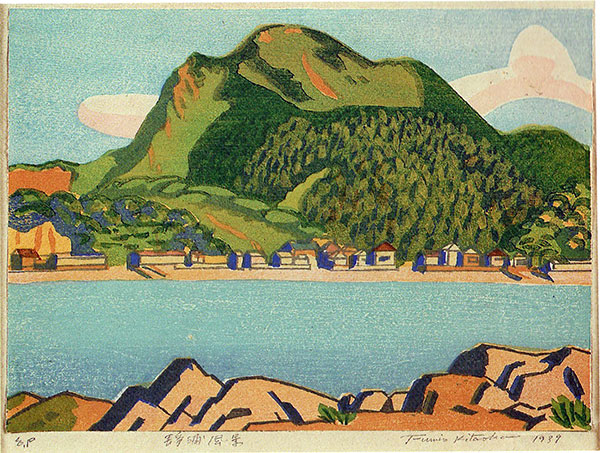 |
| Kitaoka: Shizuura fûkei (View of Shizuura: 静浦風景), 1939, wood engraving (image 200 x 280 mm) |
While under Onchi's spell, Kitaoka explored abstraction, as did some of the other disciples, however briefly. An example from around 1954 (probably before Kitaoka's sojourn in Paris in 1955-56) has been identified as "Two women." It is not surprising that the shapes are geometric and the composition linear, given Kitaoka training and the importance of line in wood engraving, plus the influence of Hiratsuka's ragged-edge lines. This is a far cry from Onchi's soft-edged forms, but nevertheless, the master's influence is there, not only in selecting the mode of abstraction for woodcuts, but also specifically in the white circles, truncated shapes, and simplicity of forms.
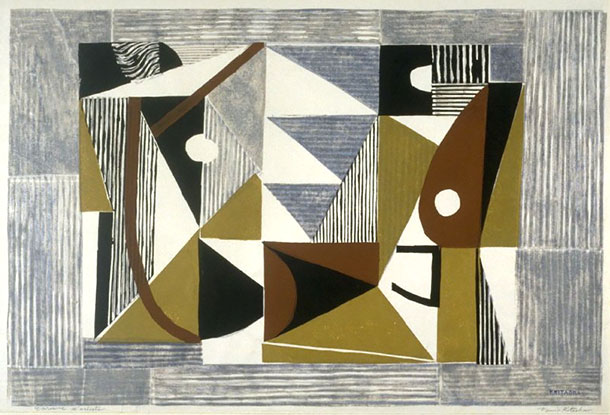 |
| Kitaoka: "Two women," c. 1954, woodcut (image: 397 x 590 mm) |
From as early as 1939, Kitaoka worked in wood engraving, or what in Japanese is called itame mokuhan ("cross-grain" woodcut: 板目木版). He took further instruction in this and other techniques some years later when he attended the Ecole des Beaux Arts, Paris in 1955-56. Engraving involves cutting with graver tools against the end grain, unlike the Japanese ukiyo-e method of cutting with the grain. The lines are "engraved" or cut into (below) the surface, so that the effect is one of white lines on a dark background, in contrast to the Japanese method of cutting the wood away from the lines, leaving them in relief. The end-grain technique gave Kitaoka's early monochrome works a European flavor, although the subjects were Japanese.
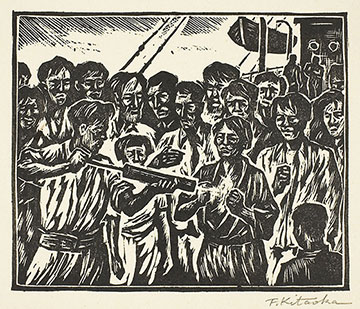 Kitaoka's series Sokaku e no tabi (Return to the home country: 祖国への旅) from 1947 chronicled the difficult and humiliating repatriation to Japan for his family and many other Japanese citizens posted during the war in China. The print titled Jôriku mae no DDT (DDT before disembarkation: 上陸前のDDT), the final scene from a total of 17, depicted Japanese ex-patriots returning home after a four-day voyage on a cargo boat. Upon arrival at the port of Sasebo in Kyushu, passengers were quarantined before they were allowed to enter their homeland. Here, the (now) shocking use of the environmentally harmful insecticide DDT sprayed directly on a passenger is depicted with brutal honesty.
Kitaoka's series Sokaku e no tabi (Return to the home country: 祖国への旅) from 1947 chronicled the difficult and humiliating repatriation to Japan for his family and many other Japanese citizens posted during the war in China. The print titled Jôriku mae no DDT (DDT before disembarkation: 上陸前のDDT), the final scene from a total of 17, depicted Japanese ex-patriots returning home after a four-day voyage on a cargo boat. Upon arrival at the port of Sasebo in Kyushu, passengers were quarantined before they were allowed to enter their homeland. Here, the (now) shocking use of the environmentally harmful insecticide DDT sprayed directly on a passenger is depicted with brutal honesty.
Two early wood engravings that are often paired together (although not conceived as a diptych) were first printed in 1951 (see below). On the left, Kitaoka portrayed the writer Nagayo Yoshirô (長與善郎 1888-1961), a novelist, playwright, and critic whose works were highly acclaimed. He was also involved in humanitarian social movements and liberal political causes. The engraving is printed in black pigment sumi (carbon black, made from soot, water, and glue: 墨 or 墨) on large format paper (477 x 379 mm) with reflective specks embedded throughout (used for the first edition of this work). It is signed and dated in pencil at the edge of the paper far away from the image in the lower margin. There is also a keyblock signature at the lower right of the image. Kitaoka's composition does not have a single vanishing-point perspective for the receding space, but rather blends multiple perspectives as the point of view shifts across the image. The quality of the engraving is reminiscent of European-style end-grain engraving. The in-situ depiction of the famous writer is one of the most compelling portraits in modern Japanese art.
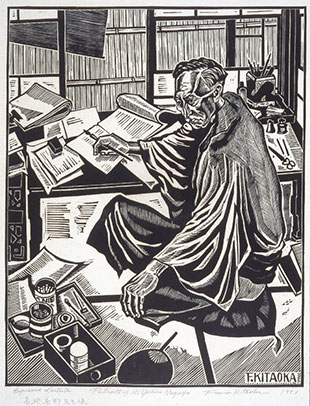 |
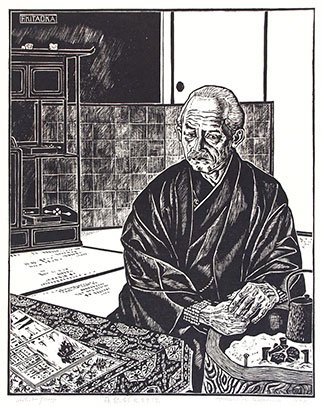 |
| Kitaoka: Portrait of Nagayo Yoshirô, 1951 1st edition, itame mokuhan (image 384 x 304 mm) |
Kitaoka: Portrait of Fujikake Shizuya, 1951 2nd edition, itame mokuhan (image 395 x 314 mm) |
In a similar manner (above right), Kitaoka portrayed another notable figure in the arts, the professor and art historian Fujikake Shizuya (藤掛静也 1881–1958). Fujikake was a professor of art history at Tokyo Imperial University (Tokyo Teikoku Daigaku) and a connoisseur of ukiyo-e who also played a key role in touting the value of contemporary prints to Japanese cultural authorities. In a post-war revision of his little English-language book Japanese wood-block prints, an added section called "New schools of picture printing" featured more than 70 pages on sôsaku hanga. The impression shown here is not on the early speckled paper, so it would be a later printing whose exact date is difficult to determine (perhaps in the 1960s?). The contemplative view of the notable professor, seemingly lost in thought, is another triumph of modern Japanese portraiture.
Later in his career, Kitaoka began working in a more decorative style as he produced picturesque views of landscapes and rural scenes, as well as still life, often brightly colored with thickly applied pigments. Below left is a large-format view (image 560 x 420 mm) from an edition of 100 entitled "Pond in autumn, Kokedera [Moss garden: 苔寺]." Kokedera is the popular name for the famous gardens at the Rinzai Zen Buddhist Saihô Temple (西芳寺) in Kyoto, consisting of acres of moss, trees, ponds, rocks, and houses for the tea ceremony. The moss garden, situated in the eastern temple grounds, is arranged as a circular promenade centered on Golden Pond (黄金池, ôgonchi) and shaped like the ideogram for kokoro ("heart" or "mind": 心). The site contains three small islands: Asahi Island (朝日島), Yûhi Island (夕日島), and Kiri Island (霧島). The area around the pond is said to be covered with more than 120 varieties of moss, believed to have started growing after the flooding of the temple grounds in the Edo Period. The intensity of Kitaoka's colors in a strikingly higher key is very different from his earlier works shown above. Five years later, Kitaoka produced a still life of ômugai (nautilus shells: おぅむ買) in smaller format (image 331 x 241mm) in an edition of 100. Set against a pitch-black background, the shells seem illuminated as if by stagecraft. The effect is rather dramatic, resulting in a compelling design.
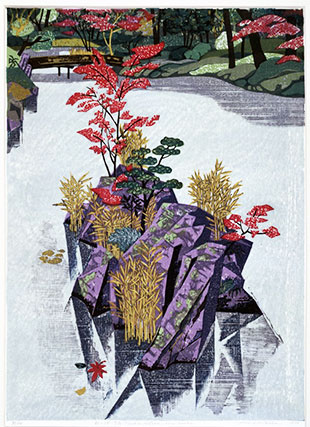 |
 |
| Kitaoka: Pond in autumn, Kokedera, 1970 Edition of 100 (image 560 x 420 mm) |
Kitaoka: ômugai (Nautilus shells: おぅむ買), 1975 Edition of 100 (image 331 x 241mm) |
From at least the mid 1970s, Kitaoka produced various meisho (views of famous places: 名所) using a colorful palette and a pleasing picturesque style. Presumably, these designs appealed to both Japanese and foreign collectors. The example shown below is titled ômogokei aki no iro (ômogo Gorge in autumn colors: 面河渓秋の色), printed in 1982 from an edition of 100. This is a well-known scenic area, popular for hiking and rafting, in Ehime Prefecture, Shikoku. ômogokei also attracts many visitors at the peak of fall foliage in early November. Kitaoka's design depicts the rapids surging through the gorge on a sunny day with intensely bright autumn leaves on the distant trees, tumbling down the rapids, and scattered on the chiseled rocks in the foreground.
 |
| Kitaoka: ômogokei aki no iro (ômogo Gorge in autumn colors: 面河渓秋の色), 1982 (400 x 550 mm) |
Works by Kitaoka are held in the the Art Gallery of New South Wales; Art Institute of Chicago; British Museum, London; Carnegie Museum of Art, Pittsburgh; Fine Arts Museums of San Francisco; Honolulu Museum of Art; Japanese Museum of Israel; Los Angeles County Museum of Art; Museum of Fine Arts, Boston; Museum of Modern Art, New York; National Museum, Warsaw; National Museum of Asian Art, Smithsonian, Washington, DC; National Museum of Modern Art, Tokyo; Philadelphia Museum of Art; Rhode Island School of Design, Providence; Worchester Art Museum, MA. © 1999-2021 by John Fiorillo
BIBLIOGRAPHY
- Catalogue of Collections [Modern Prints]: The National Museum of Modern Art, Tokyo (Tokyo kokuritsu kindai bijutsukan shozô-hin mokuroku, 東京国立近代美術館所蔵品目録). 1993, pp. 116-120, nos. 1067-1110.
- Fujikake, Shizuya: Japanese Woodblock Prints. Tokyo: Japan Travel Bureau, Tourist Library Vol. 10, 1957, pp. 125-195.
- Hokkaidô Museum of Modern Art: Kitaoka Fumio no sekai ten (Exhibition of Fumio Kitaoka's world: 北岡文雄の世界展), 1992.
- Keyes, Roger: Break with the Past: The Japanese Creative Print Movement, 1910-1960. San Francisco: Fine Arts Museums of San Francisco, 1988, p. 19 & plate 21.
- Machida City Museum of Graphic Arts (町田市立国際版画美術館): Kitaoka Fumio mokuhanga ten (Exhibition of the prints of Fumio Kitaoka: 北岡文雄木版画展), 1988.
- Petit, Gaston and Arboleda, Amadio: Evolving Techniques in Japanese Woodblock Prints. Tokyo: Kodansha International,1977, pp. 113–117.
- Smith, Lawrence: Japanese Prints during the Allied Occupation 1945-1952. London: British Museum Press, 2002.
- Smith, Lawrence: The Japanese Print since 1900: Old dreams and new visions. London: British Museum Press, 1983, pp. 132 and 109. no. 108.
- Smith, Lawrence: Modern Japanese Prints 1912-1989. London: British Museum Press, 1994, p. 62 and plate 109.
- Statler, Oliver: Modern Japanese Prints: An Art Reborn. Rutland & Tokyo: Tuttle, 1956, pp. 152-153 and 201, plates 86-87.
Viewing Japanese Prints |